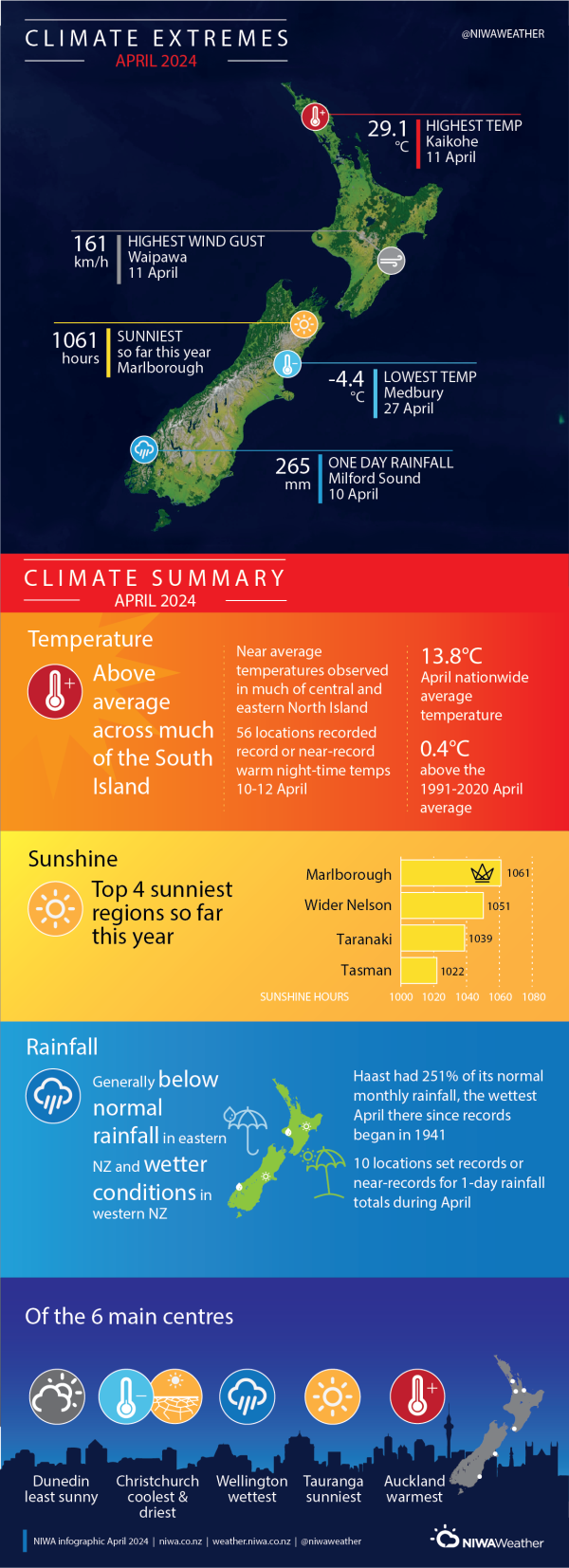| Temperature | Temperatures were above average (0.51°C to 1.20°C above average) or well above average (>1.20°C above average) in much of Northland, parts of Auckland, the Coromandel Peninsula, parts of Hawke’s Bay, Manawatū-Whanganui, Wellington, Tasman, Canterbury, Otago, and Southland. Near average temperatures (±0.50°C of average) were observed in much of the central and eastern North Island, Nelson, Marlborough, West Coast, and Fiordland. |
| Rainfall | Rainfall was above normal (120-149% of normal) or well above normal (>149% of normal) in parts of Taranaki, eastern Marlborough, the central and lower West Coast, Fiordland, and western Southland. Below normal (50-79% of normal) or well below normal (<50% of normal) rainfall was observed in eastern Northland, parts of Auckland, the Coromandel Peninsula, much of the central, eastern, and lower North Island, Tasman, Canterbury, and northern Otago. Near normal rainfall (80-119% of normal) was observed elsewhere. |
| Soil Moisture | At the end of April, soil moisture levels were below normal or well below normal in northern and eastern Northland, much of Auckland, the Coromandel Peninsula, Bay of Plenty, southern Taranaki, the eastern and lower North Island, Tasman, Nelson, western Marlborough, and Canterbury. Soil moisture levels were near normal or above normal in western Northland, western Waikato, northern Taranaki, eastern Marlborough, the West Coast, interior Otago, and Southland. |
Overview
April 2024 was characterised by lower than normal mean sea level pressure (MSLP) located south of Aotearoa New Zealand and higher than normal pressure to the north of the country. This produced more northwesterly airflows than normal and contributed to the observed rainfall pattern during April, where the west of both islands generally saw much more rainfall than eastern areas. This was characteristic of a continued, but weakening, El Niño during April. The conditions during the month were fairly mundane with the exception of an atmospheric river that brought high-impact weather to the country from 9-12 April. Very heavy rain affected the West Coast, where high-elevation stations including Tuke Tuke and Cropp Waterfall received around 1,000 mm of rain, or about 10% of their annual normal rainfall in just three days. This resulted in slips and closed roads in the West Coast and Southland, while more than 70 flights around the country were either cancelled or delayed during the event. In addition, high winds resulted in power outages across several Auckland suburbs on 11 April. (see Highlights and extreme events section below for more details).
Temperatures were above average (0.51°C to 1.20°C above average) or well above average (>1.20°C above average) in much of Northland, parts of Auckland, the Coromandel Peninsula, parts of Hawke’s Bay, Manawatū-Whanganui, Wellington, Tasman, Canterbury, Otago, and Southland. Near average temperatures (±0.50°C of average) were observed in much of the central and eastern North Island, Nelson, Marlborough, West Coast, and Fiordland.
The nationwide average temperature in April 2024 was 13.8°C. This was 0.4°C above the 1991-2020 April average from NIWA’s seven station temperature series which begins in 1909.
Rainfall was above normal (120-149% of normal) or well above normal (>149% of normal) in parts of Taranaki, eastern Marlborough, the central and lower West Coast, Fiordland, and western Southland. Below normal (50-79% of normal) or well below normal (<50% of normal) rainfall was observed in eastern Northland, parts of Auckland, the Coromandel Peninsula, much of the central, eastern, and lower North Island, Tasman, Canterbury, and northern Otago. Near normal rainfall (80-119% of normal) was observed elsewhere.
Further Highlights:
- The highest April temperature was 29.1°C, observed at Kaikohe on 11 April.
- The lowest April temperature was -4.4°C, observed at Medbury on 27 April.
- The highest 1-day rainfall was 265 mm, recorded at Milford Sound on 10 April.
- The highest wind gust was 161 km/h, observed at Waipawa on 11 April.
- Of the six main centres in April 2024, Auckland was the warmest, Christchurch was the coolest and driest, Tauranga was the sunniest, Wellington was the wettest, and Dunedin was the least sunny.
- Of the available, regularly reporting sunshine observation sites, the sunniest four regions so far in 2024 are Marlborough (1061 hours), wider Nelson (1051 hours), Taranaki (1039 hours), and Tasman (1022 hours).



